Harlech is a seaside resort which lies on Tremadog Bay, in the Snowdonia National Park, at the northern edge of the ancient county of Harlech. The town is famous for its fine castle, part of the infamous ‘ring of iron’ of castles built by King Edward I, to subjugate the people of Wales. Its construction begun in 1283. It was later captured by Owain Glyndŵr, and was later a stronghold of Henry Tudor, the father of King Henry VIII. The war memorial to the ‘Men of Harlech’ is situated in a prominent position in Harlech High Street, opposite St. Tanwg’s Church, and commemorates a total of 32 local men who died as a result of both World Wars. Their names are etched on a copper plaque inside a glass case.
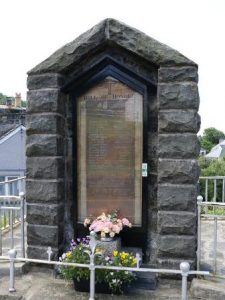
The Great War, 1914-1918
Isaac Gwilym Bevers, Second Lieutenant, Royal Welsh Fusiliers. Isaac was born at Henley, Oxfordshire on 10 May 1893, the son of Walter Bevers and Margaret Bevers (née Evans). Following the death of his father in 1902, the family moved back to Margaret’s native Merionedd, and lived at Trum Orthin, Harlech, near to her home of Llanfair. Isaac was educated at Barmouth School and gained his BSc at Bangor University prior to being commissioned into the Royal Welsh Fusiliers on 14 November 1914. He had served with the regiment at Gallipoli before being invalided home, where he got engaged to Gracie Thomas, of 298, High Street, Bangor. Bevers was posted to Whittington Camp, near Oswestry before being transferred to the 16th Battalion, Royal Welsh Fusiliers. The battalion was by then at Ypres with the 38th (Welsh) Division and on 31 July 1917 took part in the famous assault on Pilckem Ridge, during the opening day of the Third Battle of Ypres. Isaac is listed as having been killed in action on 2 August 1917, but he must have died of wounds suffered during the assault, as he is buried behind the lines in Dozinghem Military Cemetery, Belgium. The 24-year-old was due to go home on leave on the following day, to marry his fiancée, Gracie. Isaac is commemorated on war memorials at Bangor; Bangor University; and at Llanfair.
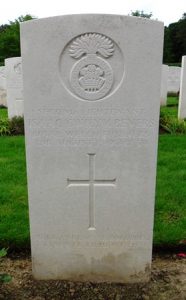
Evan Douglas Davies, Private, 15936, South Wales Borderers. Evan was born at Bryncrug, Towyn in 1895, the son of Evan Jones and Lily Davies. His parents then moved and lived for several years at Quebec Road, Llanbadarn, but by the time of the outbreak of war, were living at Caerinion, Harlech. Evan enlisted at Aberystwyth into the 8th Battalion, South Wales Borderers. The battalion formed at Brecon in 1914, moving to Seaford in 67 Brigade, 22nd Division, and on 6 September 1915 landed at Boulogne. On 30 October 1915 the Division sailed from Marseilles and arrived Salonika about 12 November 1915, where it remained for the rest of the war. Evan had fought with the battalion since its arrival in France, and had fought throughout the campaign in Salonika. He was killed in action there when a shell hit his dugout on 27 July 1918, aged 22, and is buried at Karasouli Military Cemetery, Salonika. His parents later moved to Tyn-y-Coed Gardens, Arthog. He is also commemorated at Llanbadarn.
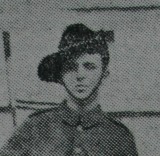
Evan Evans, Corporal, 39185, Royal Welsh Fusiliers. Evan was the son of Griffith and Mary Evans, of Brwynllynau, Harlech. He worked as a farm labourer at Bootle prior to enlisting at Wrexham into the Royal Welsh Fusiliers on 10 December 1915. He was posted to the 3rd Battalion, Royal Welsh Fusiliers at Litherland and after training was posted to the Base Depot in France on 25 October 1916. Initially destines for the 2nd Battalion, RWF, he was instead posted to the 16th Battalion, RWF, which was attached to the 38th (Welsh) Division, and joined the battalion at the Canal Bank positions, north of Ypres on 6 November 1916. The Division held the line here following its move from the Somme earlier in the year, up until launching its assault on Pilckem Ridge, during the opening phase of the Third Battle of Ypres, on 31 July 1917. Following its success at Ypres, the Division was moved to positions near Armentieres to rest, leaving the Ypres sector on 10 September. Evan was promoted corporal soon afterwards. On 19 September 1917 his battalion was in the line near Sailly-Sur-La-Lys when it came under fire from German trench-mortar batteries. Evan was killed in action during the explosion of one of their shells that day. The 24-year-old is buried in Erquinghem-Lys Churchyard Extension, France. Evan is also commemorated on the Llanfair War Memorial.
William Jones Hughes, Private, 532267, Canadian Army Medical Corps. William was born at Harlech on 30 January 1891, the son of Morris Hughes and Mary Hughes (nee Jones), of Tanrallt. After leaving Harlech School he emigrated to Canada in 1910 and settled at Winnipeg where he worked as a butchers delivery driver. He married Jenny Jones, of Talsarnau, in Winnipeg on 9 August 1910, and the couple had a daughter, Mary Elizabeth, born on 12 January 1912. On 3 March 1916 he enlisted into the Canadian Army Medical Corps and arrived in France on 12 August, joining the 12th Field Ambulance, CAMC. He was a stretcher bearer, carrying out one of the bravest and most hazardous roles. On 14 April 1918 he was wounded whilst attempting to rescue another comrade and was evacuated to the 42nd Casualty Clearing Station at Aubigny, where he died of his wounds that same day, aged 27. He is buried in Aubigny Communal Cemetery Extension, France.
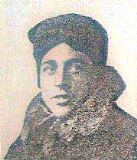
David William Humphreys, Able Seaman, J/15968, Royal Navy. David was born at Barmouth on 10 March 1896, the son of William and Elizabeth Jane Humphreys. By 1911 the family was living at Oswestry, where David and his father worked for the Cambrian Railways, and then prior to the war the family had moved to Station House, Harlech. David had enlisted into the Royal Navy on 10 March 1912, signing up for 12 years. His first posting was aboard HMS Impregnable, as a Boy Sailor, and he then served aboard HMS Duncan before gaining a posting aboard the Town-class cruiser, HMS Southampton, where he was promoted to Able Seaman. Southampton had been built by John Brown & Company and was launched on 16 May 1912, before joining the 1st Battle Squadron and she became flagship of the 1st Light Cruiser Squadron in July 1913. She took part in the Battle of Heligoland Bight, and later in the Battle of Dogger Bank in early 1915. Southampton was part of Admiral John Jellicoe’s force which attacked the German High Seas Fleet at the Battle of Jutland on 31 May 1916, acting as flagship of 2nd Light Cruiser Squadron. Southampton torpedoed and sank the German light cruiser SMS Frauenlob, but sustained damage herself in the battle. David was killed in action during the battle that day. The 20-year-old was buried at sea and is commemorated on the Portsmouth Naval Memorial, Hampshire. He is also commemorated at Barmouth.
Edward Jones, Private, 12610, Somerset Light Infantry. Edward was the son of Robert and Catherine Jones, of Hendre, Harlech. He worked as a collier at South Wales prior to the war and lived with his wife Mary Ann Jones at 8, Tynygraig Road, Llanbradach. Edward enlisted at Pontypridd into the 6th Battalion, Somerset Light Infantry, which recruited heavily in the valleys. The battalion moved to Aldershot as part of 43 Brigade, 14th (Light) Division and on 21 May 1915 landed at Boulogne. The Division was to see its first action during the Action of Hooge, where the Division became the first to be attacked by the German use of flamethrowers. It then fought at the Second attack on Bellewaarde. In July 1916 the Division moved to the Somme, and fought at the Battle of Delville Wood, and then the Battle of Flers-Courcelette, and in March 1917 followed the German Retreat to the Hindenburg Line. May saw the Division at Arras, where it took part in the First Battle of the Scarpe, and later at the Third Battle of the Scarpe, before being sent north to take part in the Third Battle of Ypres. On 17 August the Division moved from reserve to the Dickebusch area and the company commanders then met to discuss the forthcoming offensive. On 20 August the Division took the front line over and assaulted Inverness Copse on the morning of 22 August 1917, but upon reaching their objectives, a German counter-attack inflicted heavy casualties. Edward was taken prisoner during the day, and was among around 350 casualties suffered by the 6th Battalion, Somerset Light Infantry during the days fighting. He was taken to a prisoner of war camp near Rethel, in the Champagne region, where he died on 11 November 1917, aged 30. Edward is buried in Rethel French National Cemetery, France.
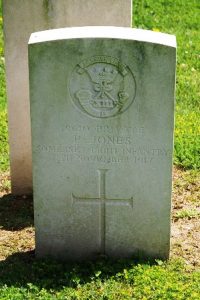
Griffith Jones, Corporal, 4179194, Royal Welsh Fusiliers. Griffith was born in Harlech in 1894, the illegitimate son of Elizabeth Jones, of Grogan Cottage, Llechwedd, Harlech. He enlisted in September 1914 and had served with the Royal Welsh Fusiliers during the war, and remained in the army after the Armistice. Very little else is known of him, but he died on 4 February 1922, aged 28. He is not commemorated by the CWGC.
Griffith Morris Jones, Lieutenant, Westmorland and Cumberland Yeomanry. Griffith was born at Llanfair on 20 April 1890, the son of the Reverend Robert Jones and Ellen Jones. His father was, at the time, vicar of St. Mary’s Church. He was educated at St John’s College, Ystrad Meurig and at Jesus College, Oxford, graduating BA in 1917. Griffith had enlisted into the Westmoreland and Cumberland Yeomanry in September 1914 and was commissioned as Second Lieutenant on 23 October 1915. He married Elizabeth Cragg, of North Villa, Edentown, Carlisle, that year. Griffith does not appear to have served overseas, but his time in khaki ruined his health and he took ill in the summer of 1918, before being sent to the Pinewood Sanatorium, Wokingham. He was diagnosed as suffering from tuberculosis and was then transferred to the Matlock Sanatorium in Derbyshire, where he died of tuberculosis on 13 December 1918, aged 28. His remains were brought home for burial in St. Mary’s Churchyard, Llanfair. He is not commemorated on the Harlech memorial, but at Llanfair.
Thomas Jones, Private, 33495, Royal Welsh Fusiliers. Thomas was the son of Evan and Catherine Jones, of 8, Dolrhedyn Terrace, Tanygrisiau, Blaenau Ffestiniog. He lived at Llechwedd Canol, Harlech prior to the war, and worked as a haulier. Thomas enlisted at Tonypandy into the 10th Battalion, Welsh Regiment on 10 November 1914. He was posted to Rhyl with the battalion, where it trained before being transferred to the 19th Welsh. His record after arriving in Rhyl was terrible. Thomas was first punished for drunkenness in January 1915 and then had several punishments for being absent on parade and being unshaven on parade and his final one for drunkenness, resisting arrest and trying to escape from the guard room. He then went AWOL before re-enlisting at Machynlleth into the Royal Welsh Fusiliers. He was posted to France early in 1916, joining the 1st Battalion, Royal Welsh Fusiliers, which was attached to 22 Brigade, 7th Division. In the summer of 1916, the Division was on the Somme, and took part in the Battle of Albert, where it captured Mametz village on the opening day of the battle. It then had a brief rest at Heilly before moving back into the action and on its way to the front, marched past the withdrawing 38th (Welsh) Division, which had suffered a mauling at Mametz Wood. On the night of 13 July the 1st RWF moved forwards past Mametz Wood to support the attack on the German line in front of Bazentin-le-Petit Wood. Zero hour was at 03.35 and the men left their trenches and moved into the Hammerhead section of Mametz Wood, and at 12.40 the 1st RWF received orders to reinforce the attacking battalions. Thomas was killed during the fighting that day. The 29-year-old is buried in Caterpillar Valley Cemetery, Longueval, France.
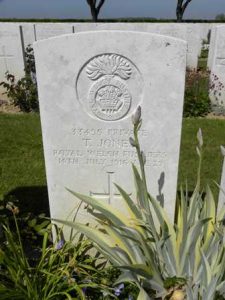
Evan Lloyd, Private, 291538, Royal Welsh Fusiliers. Evan was the son of John and Mary Lloyd, of Tynymaes, Llanfair. He worked as a bootmaker prior to enlisting at Harlech into the 7th Battalion, Royal Welsh Fusiliers on 23 February 1916, and was then posted to Wrexham Barracks. Evan remained on home service until 4 September 1916 when he embarked for the Middle East and joined the 1/7th Battalion, Royal Welsh Fusiliers at Egypt, where it was attached to 158 Brigade, 53rd (Welsh) Division. The Division had seen action in Gallipoli in 1915 and after being evacuated had joined the EEF in Egypt, helping drive the Turks out of the Sinai and securing the Suez Canal, before taking part in the offensive into Palestine. The coastal city of Gaza was to the north of the canal, and was the centre for the Turkish defensive position in Palestine. On 26 March 1917 the First Battle of Gaza was launched and the 53rd (Welsh) Division was among the attacking forces, attacking the Gaza positions from the south. The day ended in chaos for the EEF, and most of the ground gained was later ceded back to the Turks. Among the many casualties suffered during the days fighting was Evan. He was 21 years old and is commemorated on the Jerusalem Memorial, Israel. Evan is also commemorated on the Llanfair War Memorial.
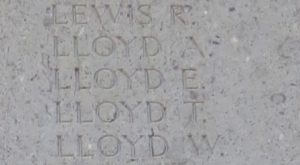
Ellis Owen, Lance Sergeant, 2791, Royal Welsh Fusiliers. Ellis was the son of Simon and Gwen Owen, of 7, Rock Terrace, Harlech. He was a pre-war regular soldier, and was based at Wrexham Barracks with the 3rd Battalion, Royal Welsh Fusiliers in 1911. He had probably left the army prior to the outbreak of war, as he then served with the 1/7th Battalion, Royal Welsh Fusiliers, which was a Territorial battalion, attached to North Wales Brigade, Welsh Division. The Division moved to Bedford in May 1915 where the formation became 158 Brigade, 53rd (Welsh) Division. On 19 July 1915 the Division sailed from Devonport for Imbros and on 9 August 1915 landed at Suvla Bay, Gallipoli. The Division advanced into the bush, but was ill prepared, with very few maps and no knowledge of the terrain, and as a result the various battalions got lost, with chaos ensuing when the men came into contact with the Turkish defenders. Ellis was killed in action here on the following day, 10 August 1915, aged 24. He has no known grave and is commemorated on the Helles Memorial, Gallipoli. His brother, Robert Lewis Owen, was killed two months later.

George Owen, Private, 3264, Royal Welsh Fusiliers. George was the son of William and Margaret Owen, of Ffordd Groes, Harlech. He worked as a waggoner prior to the war and in 1913 married Elizabeth Jones, before the couple moved to Ty Llewelyn, Nefin. George enlisted at Carnarvon into the 1/6th Battalion, Royal Welsh Fusiliers, which was a Territorial battalion, attached to North Wales Brigade, Welsh Division. The Division moved to Bedford in May 1915 where the formation became 158 Brigade, 53rd (Welsh) Division. On 19 July 1915 the Division sailed from Devonport for Imbros and on 9 August 1915 landed at Suvla Bay, Gallipoli. The Division advanced into the bush, but was ill prepared, with very few maps and no knowledge of the terrain, and as a result the various battalions got lost, with chaos ensuing when the men came into contact with the Turkish defenders. George survived the initial chaotic fighting, but the strain of life at Gallipoli proved too much for him and he died of heart failure on 3 September 1915, aged 23. He has no known grave and is commemorated on the Helles Memorial, Gallipoli. He is also commemorated on the Llanfair War Memorial. His brother William also fell.
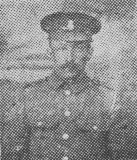
Matthew Owen, Lance Sergeant, 502, Welsh Guards. Matthew was the son of John and Ellen Owen, of Iwerddon, Harlech. He was a professional golfer at Warrington prior to the war, when he enlisted into the Grenadier Guards. He was posted to the Depot in London, where he met Pleasance Robina Reed, a dressmaker. They married in London on 14 August 1915, after Matthew had volunteered to transfer to the Welsh Guards, but their marriage was to be short lived, as he left for France soon after the wedding. The Welsh Guards was raised by Royal Warrant of 26 February 1915, at White City, before landing at Le Havre on 18 August 1915, becoming attached to 3rd Guards Brigade, Guards Division. The Division saw its first major action during the Battle of Loos, which began on 25 September 1915. Moving into their advanced positions by the morning of 27 September, the Welsh Guards received orders that the 3rd Guards Brigade would move into Loos village, before assaulting Hill 70. The fighting was so fierce during the assault that the men said it seemed as if a storm was raging above their heads. Matthew was killed at some time during the day. The 28-year-old has no known grave and is commemorated on the Loos Memorial, France.
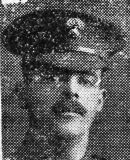
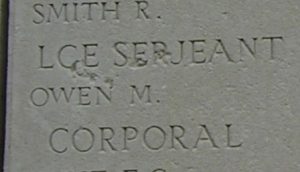
Robert Lewis Owen, Rifleman, R/921, King’s Royal Rifle Corps. Robert was the son of Simon and Gwen Owen, of 7, Rock Terrace, Harlech. He trained as a shoemaker before gaining work as a collier at Porth in South Wales prior to the war. Robert enlisted at Porth into the 12th Battalion, King’s Royal Rifle Corps on 2 September 1914, and moved to Bisley with the battalion. The battalion embarked for France on 22 July 1915 as part of 60 Brigade, 20th (Light) Division, and the Division moved to the Fleurbaix Sector for trench familiarisation and training. When the Battle of Loos was launched on 25 September 1915 the Division fought a diversionary attack towards Fromelles. The Division remained in the same sector over the coming weeks. On 7 October 1915 the 12th KRRC moved to billets at Laventie and over the coming days the men provided working parties at Rue de Paradis. Robert was killed whilst on a working party with the 61st Trench Mortar Battery on 13 October 1915, aged 20. He is buried in Rue-Du-Bacquerot No. 1 Military Cemetery, Laventie, France. His brother Ellis had been killed at Gallipoli two months earlier.
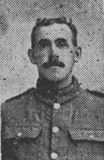
William Owen, Private, 1506, Welsh Regiment. William was the son of William and Margaret Owen, of Llechwedd Canol, Harlech. He worked as a farm labourer prior to enlisting into the Welsh Regiment at Merthyr prior to the war and was posted to the 2nd Battalion, Welsh Regiment. The battalion was attached to 3 Brigade, 1st Division and was training at Aldershot when war broke out. On 13 August 1914 the 2nd Welsh landed in France with the 1st Division, before the entire Division moved to the area of Mons. The Division then took part in the Battle of Mons, and in the retreat to the Marne, where the Germans were stopped. The Division then fought at the Aisne, and at Chivy Ridge, before being moved north to Ypres. Here it fought at the First Battle of Ypres, where the 2nd Welsh played an important part in stopping the German drive towards Ypres, on the Menin Road. The Division then wintered in Flanders, taking part in the Christmas Truce. On 12 January 1915, 3 Brigade was sent to the Givenchy area and the 2nd Welsh made its HQ in Festubert. At 07.30 on 25 January 1915 heavy artillery fire came down upon the British line, followed by large numbers of German infantry. Heavy fighting raged during the day, which cost the 2nd Welsh 19 men killed and 40 men wounded. Among the dead was 26-year-old William. He has no known grave and is commemorated on the Le Touret Memorial, Richebourg-L’avoue, France. He is also commemorated on the war memorial at Troed-y-Rhiw, Rhondda.
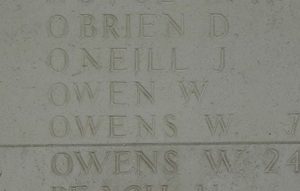
William Owen, Gunner, 13166, Royal Marine Artillery. William was born on 23 May 1890, the son of William and Margaret Owen, of Ffordd Groes, Harlech. He enlisted into the Royal Marines at Bristol on 8 November 1912, under the name of George Owens, and was posted to the RM Barracks at Eastney, where he trained before becoming a gunner with the Royal Marine Artillery. On 10 January 1914 he was posted aboard the battleship HMS Zealandia. Following the outbreak of war, Zealandia was transferred back to the 3rd Battle Squadron of the Grand Fleet. For the next two years she frequently put to sea to search for German vessels, but saw no action during this period. By November 1915, Zealandia was detached to serve in the Gallipoli Campaign, but the peninsula was evacuated by January 1915, so Zealandia returned to Britain, re-joining the 3rd Battle Squadron. William remained aboard her until she was paid off in late 1917 and converted into a gunnery training ship. He then returned to Eastney Barracks. During the summer of 1918, William was taken ill and hospitalised in Portsmouth Royal Naval Hospital. He died there of pneumonia on 21 July 1918, aged 25. William’s remains were conveyed back home for burial in St. Mary’s Churchyard, Llanfair. He is also commemorated on the Llanfair War Memorial. His brother George had died at Gallipoli in 1915.
Owen Parry, Private, 25753, Welsh Regiment. Owen was born in Grogan Terrace, Harlech in 1898, the illegitimate son of Jennett Parry. He was raised by his grandmother, Ann Parry, at Llechwedd Canol, Harlech. He was working in the South Wales valleys prior to the war and enlisted at Pontypridd into the 17th Battalion, Welsh Regiment. The battalion was raised in December 1914 as a Bantam Battalion and went to Rhyl attached to the 43rd (Welsh) Division, of the Welsh Army Corps. By July 1915 the battalion had moved to Prees Heath in 119 Brigade, 40th (Bantam) Division and in June 1916 landed in France. This Division was composed of bantam units and others which had a mixture of regulation-height and shorter men and moved to the front near Loos. Late in 1916 it moved south to the Somme, and fought at the Battle of the Ancre, and remained in the area over the winter. In March 1917 the Germans withdrew to their shortened line, called the Hindenburg Line, and the 40th Division was one of the Divisions that followed the withdrawal. On the night of 5/6 July 1917 the 17th Welsh relieved the 18th Welsh in the Gonnelieu sector. Owen was killed here during a patrol on 9 July 1917, aged 19. He is buried in Fins New British Cemetery, Sorel-Le-Grand, France. Owen is also commemorated on war memorials at Pontypridd and Cilfynydd.
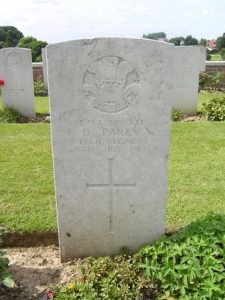
Leon Rees Roberts, Rifleman, 4387, London Regiment. Leon was born in London on 7 December 1888, the son of Henry and Kate Roberts, of 68 Theobalds Road W. C. His grandfather was Rees Roberts, of Bronwen Terrace, Harlech, and Leon and his brothers were regular visitors. He enlisted in London into the Inns of Court Officer Training Corps and after training, was posted to France on 14 July 1916, joining the 1/5th Battalion, London Regiment (London Rifle Brigade), which was on the Somme, attached to 169 Brigade, 56th (London) Division. The Division had fought throughout the Somme offensive that summer, taking heavy casualties, but managed to capture the village of Combles on 25 September. On 2 October 1916 the London Rifle Brigade took over a section of the line in front of Lesboeufs, relieving two other battalions, to take its turn holding the line. Over the coming days the men were kept busy improving the trenches, in terrible conditions. Leon was among four men killed here on 4 October 1916, whilst carrying out this work. The 27-year-old has no known grave and is commemorated on the Thiepval Memorial, France.
Morris Thomas, Private, 78403, Royal Welsh Fusiliers. Morris was the son of William and Gaynor Thomas, of Blaenau Ffestiniog. He was raised by his grandparents, Griffith and Mary Thomas, at Grogan Terrace, Harlech. He worked as a golf caddie prior to moving to the South Wales valleys to work as a collier. Morris enlisted at Porth, Rhondda, into the army and after completing his training was posted to France in 1918, joining the 25th Battalion, Royal Welsh Fusiliers. The battalion had originally been formed in Egypt in March 1917, by the merger of the Montgomery and Welsh Horse Yeomanry regiments, joining 231 Brigade, 74th (Yeomanry) Division and had taken part in the Palestinian campaign thereafter. In May 1918 the Division moved to France, taking over a section of the line between the La Bassée Canal and the River Lys. It remained here until entraining for the Somme on 29 August and opened its new HQ at Beaucourt Chateau. By now the Allies had launched their great offensive, all along the Western Front, and the Germans were crumbling. The 74th Division was moved forwards and took over a sector near Bouchavesnes. The Division began its advance on 2 September and over the coming days saw heavy fighting during the drive towards the Hindenburg Line. Morris was killed during an attack on the strongly defended village of Hargicourt on 8 September 1918, aged 26. He is buried in Ste. Emilie Valley Cemetery, Villers-Faucon, France.
John Griffith Williams, Private, 49800, Royal Welsh Fusiliers. John was the son of Robert and Ellen Williams, of 2 Bronwen Terrace Harlech. He lived in Liverpool prior to enlisting there into the Royal Welsh Fusiliers, and trained at Litherland Camp. He was posted to France, joining the 1st Battalion, Royal Welsh Fusiliers, which was on the Somme attached to 22 Brigade, 7th Division. The Division had taken part in the opening assault of the Battle of the Somme on 1 July 1916, capturing the village of Mametz. It then fought at the Battle of Bazentin, and the Attacks on High Wood, being among the first troops into High Wood. The Division then took part in the Battle of Delville Wood, and the Battle of Guillemont, before spending the winter on the Ancre. In March 1917 it followed up the German Retreat to the Hindenburg Line, and took part in Flanking Operations Round Bullecourt, in support of the Australian Corps. The 1st Battalion, RWF moved into the front near Mory Copse on 3 May 1917 where it received its orders to launch an assault that night. Heavy fighting raged around their objective of the railway embankment over the coming days, with the men being often held up by thick belts of barbed wire and on 5 May the battalion was relieved, moving back to Courcelles to train and rebuild before taking over the line again on 13 May after an SOS had been sent up from Bullecourt. John was killed here during terrible fighting on 15 May 1917. The 21-year-old has no known grave and is commemorated on the Arras Memorial, France.
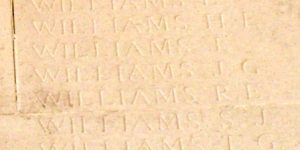
Richard Williams, Second Lieutenant, Machine Gun Corps. Richard was born on the 2nd March 1894, the son of Richard and Jane Williams of Clogwyn House, Harlech. He was educated at Barmouth County School before joining Bangor University in 1912 to study Science. He enlisted into the 17th Battalion, Royal Welsh Fusiliers in September 1915, before transferring to the Machine Gun Corps, where he was promoted to Staff Quartermaster Sergeant. He was then commissioned as Second Lieutenant into the Machine Gun Corps on 11 September 1917. Richard was posted out to France with the 41st Company, Machine Gun Corps, which was attached to the 14th (Light) Division. In March 1918 the army was re-organised, and Richards Company became the 14th Machine Gun Battalion, still attached to the 14th (Light) Division. The Division was by then in the St. Quentin sector, to the east of Grand Seraucourt, to the south of St. Quentin itself, and on 21 March 1918 was hit by the German Spring Offensive, Operation Michael. The Division suffered terrible casualties over the coming days, being driven back by overwhelming numbers of German stormtroopers. Richard was badly wounded at this time and was evacuated to a casualty clearing station near Gézaincourt where he died of his wounds on 2 April 1918, aged 24. He is buried in Gézaincourt Communal Cemetery Extension, France. Richard is commemorated on the Bangor University War Memorial and on the Denbigh War Memorial.
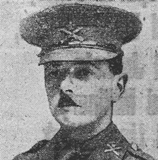
Robert Richard Williams, Private, 315636, Royal Welsh Fusiliers. Robert was born on 4 November 1881, the son of Robert and Laura Williams, of Tyn-Y-Buarth, Llanfair, Harlech. He worked as a boot repairer prior to the war, when he enlisted into the Royal Welsh Fusiliers. Robert was posted to the 23rd Battalion, Royal Welsh Fusiliers, which was a Home Service battalion, based in Norfolk with 224 Brigade, and performed coastal defence duties. Robert died at Cambridge Military Hospital on 5 September 1917, aged 35. His remains were brought home for burial in St. Michael’s Churchyard, Llanfihangel-Y-Traethau. He is also commemorated on the Llanfair War Memorial.
World War Two, 1939-1945
Hugh Caradoc Edwards, Private, 4040842, King’s Shropshire Light Infantry. Hugh was the son of Griffith Ellis Edwards and Ann Ellen Edwards, of Pen-Cerrig, Harlech. He enlisted into the army and was posted to the 4th Battalion, King’s Shropshire Light Infantry. The battalion began the war attached to the 159th Infantry Brigade, 53rd (Welsh) Division, but on 17 May 1942 the Brigade converted to motorised infantry and transferred to the 11th Armoured Division. The Division spent many months training in preparation for Operation Overlord and landed at Juno Beach, Normandy on 13 June 1944. The Division took part in the break-out from Normandy and the subsequent drive northwards through France into Belgium and Holland, into Germany. On 28 March 1945 the Division crossed the River Rhine at Wesel, and over the coming weeks worked in conjunction with the elite troops of the 6th Airborne Division. Hugh was killed in Germany on 13 April 1945, two days before the Division liberated the concentration camp at Bergen-Belsen. Hugh was 38 years old when he was killed and is buried in Becklinghen War Cemetery, Germany.
Colin John Griffith, Flying Officer, 130952, Royal Air Force Volunteer Reserve. Colin was the son of Maurice John Griffith and Ruth Marion Griffith (nee Ellis), of Hendre Mur, Harlech. He was educated at Wellington College before enlisting into the Royal Air Force Volunteer Reserve and trained as a pilot before being posted to 201 Squadron, RAF, which was a Coastal Command squadron, based at RAF Pembroke Dock. The squadron flew the Short Stirling ‘flying boat’ on anti-submarine and convoy escort duties in the Western Approaches. On 12 June 1944, Colin took off from Pembroke Dock, flying as co-pilot aboard Short Sunderland III, Serial ML760, which was despatched on an anti-submarine patrol in the Bay of Biscay. The crew was relatively experienced, and on their previous flight had sunk the German submarine U-955. This mission was to end differently, however, as the Sunderland went missing, presumed shot down by U-333, with the loss of all her crew of twelve. Colin was 22 years old when he died that day, and is commemorated on the Runnymede Memorial, Surrey.
Clarence George Owen Hammond, Gunner, 1817101, Royal Artillery. Clarence was born at Reigate, Surrey on 6 October 1906, the son of George and Violet Emily Hammond. He lived at Harlech prior to the war, and married Sarah Ann Price in 1928. Clarence joined the Royal Artillery soon after the outbreak of war and was posted to 12 Battery, 6th Heavy Anti-Aircraft Regiment, Royal Artillery. The regiment was originally in France with the BEF and was evacuated from Dunkirk in 1940. The regiment re-equipped, and defended London and the West Midlands during the Battle of Britain and The Blitz. It was then sent to the Middle East, but was diverted en-route and sent to the Far East, following the Japanese invasion of Hong Kong and Malaya. Clarence was taken prisoner by the Japanese along with the rest of the regiment, when Java fell in March 1942. He was among a large number of men transported by ‘Hell-Ship’ to work on the Thai Burma railway. Clarence died at Kuching PoW Camp on 31 October 1943, aged 40 and is buried in Labuan War Cemetery, Malaysia.
Robert Lloyd Lewis, Private, 4202035, Leicestershire Regiment. Robert was the son of William Lewis and Ellen Lewis (nee Lloyd), of Festiniog. He married Marjorie Roberts in 1939 and the couple lived at Bronallt, Harlech. Robert enlisted into the army following the outbreak of war and was posted to the 2/5th Battalion, Leicestershire Regiment. The battalion had fought with the BEF in France as part of the 138th Infantry Brigade, 46th Division and was evacuated from Dunkirk. It remained on home service for over two years until the Division was sent to North Africa in early 1943. The battalion then fought in the Tunisian Campaign, including the Battle of Kasserine Pass, and following the surrender of the Afrika Korps, took part in the Allied invasion of Italy, seeing heavy fighting at Monte Cassino. The battalion was then withdrawn and sent to the Middle East to rebuild, before re-joining the Italian campaign. It was then moved to Greece to help calm the Greek Civil War. Robert died in Greece on 16 January 1945, aged 29. He is buried in Phaleron War Cemetery, Greece.
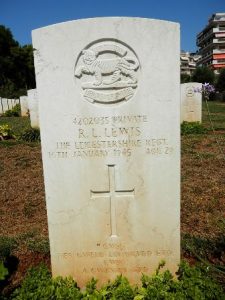
Ivor Lloyd, Marine, PLY/X 101607, Royal Marines. Ivor was born on 13 February 1921, the son of Ellis Lloyd and Sarah Jane Lloyd (nee Davies), of Ael-y-Bryn, Harlech. He enlisted into the Royal Marines, and after passing out, was posted aboard the Dido-class cruiser HMS Charybdis. Charybdis had an eventful war. She joined the Home Fleet and carried out escort duties during several mine-laying missions, then in In April 1942 she joined Force H, at Gibraltar, and carried out escort duties in the Mediterranean, taking part in many of the Malta convoys. In September 1942 she was despatched to the Atlantic, before returning to the Mediterranean to take part in Operation Torch. She returned to Britain for a refit in December 1942 and was then posted to Scapa Flow, patrolling the North Sea, before taking part in operations in the Bay of Biscay. She then returned to Gibraltar, and again escorted Mediterranean convoys. During September 1943 she joined Force V, covering the landings at Salerno and carried US General Dwight D. Eisenhower to Salerno. She returned to Plymouth the following month, but was immediately despatched back to the Bay of Biscay to hunt for the German blockade runner, Münsterland. On 23 October 1943, Charybdis was on patrol alongside two large destroyers and four Hunt-class destroyers when they contacted the Münsterland’s convoy. The German ship was being escorted by five Type 39 torpedo boats, small but very fast craft. One of these boats managed to fire two torpedoes at Charybdis, which struck her on the port side, and she sank within 30 minutes with the loss of over 400 men. Ivor’s body was recovered from the sea off the French coast at some time afterwards, and the 22-year-old was buried in St. Brieuc Western Communal Cemetery, France.
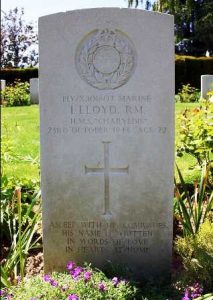
Robert David Lloyd, Sailor, Merchant Navy. Robert was born at Pwllheli on 12 February 1908, the son of William and Mary Lloyd. He married Kate Dilys Denman in 1927 and the couple set up home at Gwyndy Bach, Harlech. Robert worked as a hairdresser prior to the war, when he volunteered to serve in the Merchant Navy and was posted aboard the Liverpool registered cargo steamer SS Kavak. On 2 December 1940 Kavak was travelling from Halifax for Newport, Monmouthshire in Convoy HX-90, carrying a cargo of bauxite and pitch when she was torpedoed and sunk by the German submarine U-101, some 340 miles west of Bloody Foreland. Robert was among 25 men lost in the sinking. The 32-year-old is commemorated on the Tower Hill Memorial, London. Robert is not named on the Harlech war memorial.
Emlyn Roberts, Private, 3967604, Welch Regiment. Emlyn was the son of Morris Roberts and Martha Roberts (nee Jones), of 4, Rock Terrace, Harlech. His eldest brother had served with the Royal Navy during the Great War. Emlyn enlisted into the Welch Regiment, and was posted to the 1st Battalion, Welch Regiment. The battalion was in Palestine at the outbreak of war, and in November 1939 to sent to Egypt with the 6th Division. On 18 February 1941 the 1st Welch was assigned to CREFORCE and was sent to help defend the island of Crete. On 14 May 1941 German bombers began saturation bombing strategic targets around the island. The 1st Welch were dug in around Suda Bay and endured six days of this, and then on 20 May hordes of German paratroopers were landed on the island. Terrible fighting followed over the coming days and as German re-enforcements started to land, it was realised that the Battle for Crete was lost. The last stand for the 1st Welch came on 28 May, when the survivors of the battalion were attacked by nine German battalions and the desperate survivors began their escape across country. Some 250 men had been killed and 400 taken prisoner from the 1st Welch alone. Emlyn is officially recorded as having died on 16 June 1941, aged 25, although some records state that he died on 1 June. He was originally buried in the British Military Cemetery, in Athens, but on 2 February 1945 his remains were exhumed and he was reburied in Phaleron War Cemetery, Greece.
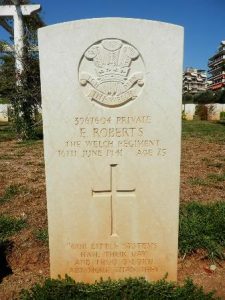
John Roberts, Private, 1133675, East Yorkshire Regiment. John was the son of Mathew and Margaret Roberts. He enlisted into the army and was posted to the 5th Battalion, East Yorkshire Regiment. The battalion was formed in June 1939, joining the 69th Infantry Brigade, 23rd (Northumbrian) Division. It was in France with the BEF in 1940 and was evacuated from Dunkirk. The battalion was then transferred to the 50th (Northumbrian) Division and was posted to North Africa, serving in the Western Desert, and in the Tunisian and Sicily campaigns before returning to England to train for the Normandy landings. John landed with the battalion during the first wave on Gold Beach on D-Day. His battalions target was the village of La Rivière, to the east of Arromanches. John was killed at some time during D-Day, 6 June 1944. The 25-year-old is buried in Bayeux War Cemetery, France.
Owen Roberts, Private, 4202117, Gloucestershire Regiment. Owen was the son of Ernest and Ann Jones, of Penrhyndeudraeth. He married Mary Roberts in 1938 and the couple lived at 3, Min-y-Coed, Harlech. Owen enlisted into the army and was posted to Rangoon, Burma, joining the 1st Battalion, Gloucestershire Regiment. The battalion was stationed in Rangoon at the outbreak of war and was hit hard following the Japanese invasion of Burma. On 7-8 March 1942 the battalion took part in desperate fighting at the Taukkyan Roadblock, which was an attempt to clear a roadblock set up by the Japanese to prevent the evacuation of the British army from Rangoon. Owen was killed at some time during these two days of ferocious fighting. He has no known grave and is commemorated on the Rangoon Memorial, Myanmar.
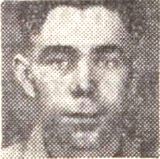
Robert John Spoonley, Leading Aircraftman, 1408798, Royal Air Force Volunteer Reserve. Robert was born on 4 August 1906, the son of William and Catherine Spoonley, of Bryngoleu, Talsarnau. He married Annie Jones in 1934 and the couple set up home at Harlech. Robert had served during the war with the Royal Air Force. He survived the war, but his service had taken a heavy toll on his health and he died at the North Wales Sanatorium, Llangwyfan Hospital, of tuberculosis on 4 January 1947, aged 40. Robert is buried in Talsarnau Methodist Chapelyard. He is not commemorated on the Harlech War Memorial.
Meirion Thomas, Leading Aircraftman, 1213831, Royal Air Force Volunteer Reserve. Meirion was the son of Mrs Sarah E. Morgan. He married Catherine Megan Roberts in 1939 and the couple set up home at Harlech. Meirion enlisted into the Royal Air Force Volunteer Reserve after the outbreak of war and was posted to Cornwall. Meirion died on active service at St. Austell on 22 May 1942, aged 26. His remains were brought home and he was buried in Rehoboth Scottish Baptist Cemetery, Harlech.
John Henry Williams, Signalman, P/JX 196510, Royal Navy. John was born in Dalston, London on 22 February 1921, the son of John Humphreys Williams and Doris Maud Williams. He was raised with his Uncle Stanley Humphreys at Harlech prior to the war. John enlisted into the Royal Navy and served aboard the lend-lease destroyer HMS Capel. On 14 June 1943 the Royal Navy was loaned the ship from the US Navy and from 9 April 1944 she became attached to the 1st Escort Group based at Belfast. She undertook several patrols in the Irish Sea before sailing from Moelfre Bay, Anglesey on 5 May 1944 to join the massive anti-submarine screen patrolling the western end of the English Channel, in order to protect the Normandy Landings of 6 June 1944. After a brief rest period in Belfast Capel returned to the Channel carry out escort duties and patrols. During the afternoon of 26 December 1944 Capel and the rest of her Escort Group were patrolling east-northeast of Cherbourg when the German submarine U-486 sighted the group and fired three torpedoes; one of which hit Capel. The stricken destroyer sank with the loss of 76 lives. John is recorded as having been killed on 27 December 1944, aged 23, the day after the sinking of Capel. He is buried in Bayeux War Cemetery, France.